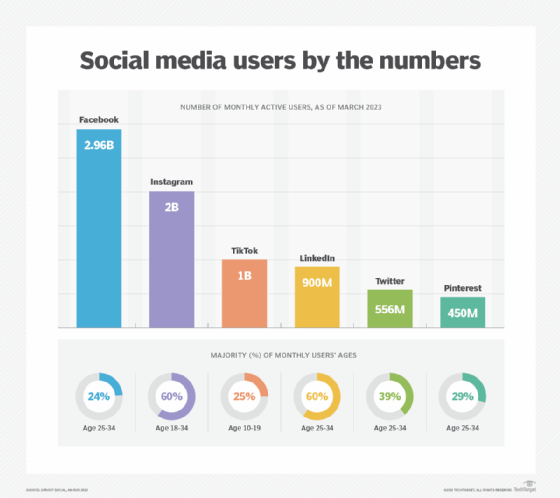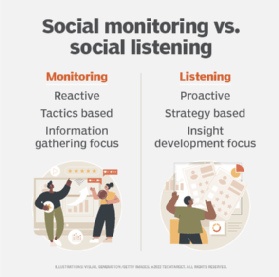20 social media terms to know (original) (raw)
Social media continues to grow and change, and businesses are using it in their marketing strategies.
Knowing the latest social media trends is essential to keep up with today's consumers. Nearly half of the global population uses some form of social media, according to Statista. Because of this, businesses are turning to social media to network with and market their services to consumers.
Here are some social media terms and buzzwords to help businesses understand the services and tools available to keep up with consumers.
1. Algorithm
Algorithms use rules to determine how data is displayed and used. With social media, these algorithms determine the content on a person's feed by ranking search results.
These algorithms prioritize content based on what they think a user will want to see based on factors such as the user's views, likes and follows. The main purpose of an algorithm is to remove irrelevant content to improve the user experience.
2. Campaign
A social media campaign is a type of marketing effort to reach potential or current customers across multiple social media platforms. Common goals for social media campaigns include the following:
- Gathering user feedback.
- Increasing web traffic.
- Building email lists.
- Driving sales.
- Improving brand engagement.
Learn social media marketing tips to boost your business.
3. Clickbait
Clickbait describes manipulative or misleading content that encourages users to click on it. These items can be an article, headline, image or video. The header is often overexaggerated, such as "You will never believe this" or "Get the best results by doing this one simple thing."
4. Creator economy
A creator economy is a type of job market where people use their skills and creativity to build their personal brand. This type of economy relies on social media to direct customers to a creator's personal website or apps.
The creators are the founders of their brand, so these entrepreneurs have complete control of how they run their business versus a gig economy, which is backed by a company.
Example of creator jobs include the following:
- Artist.
- Blogger.
- Course creator.
- Fitness coach.
- Life coach.
- Musician.
- Video blogger or YouTuber.
Creators earn money through subscriptions, merchandise, product placement, fan clubs, advertising and tipping.

Here is a breakdown of the most popular social media platforms by users.
5. Community management
Community management is how a company builds an authentic community with customers, employees and partners through interaction. The company uses opportunities to interact with their audience to grow, connect and share experiences for a positive image and engagement. Examples of community interactions include responding to online comments, creating polls or surveys, and attending local events.
6. Deinfluencing
Deinfluencing is a trend on social media where influencers tell people not to buy products. Influencers use this trend to create a relationship with followers by being honest and telling them to save their money. Deinfluencing is also used to prevent overconsumption and to limit waste.
7. Influencer
Influencers sway consumers to buy a product or service by endorsing and promoting these items on social media. Influencers typically have specialized knowledge or expertise in a subject. People follow these influencers for their opinions, as well as product reviews and different tips and tricks.
Influencers build a personal brand to get followers. Popular influencers are field experts or can include celebrities such as Justin Bieber, Kylie Jenner or Beyoncé. Other famous influencers include Khaby Lame, Huda Kattan, Lauren Conrad, Cole Sprouse and Salt Bae.
Influencers fall into various categories based on the number of followers they have. Here is a breakdown of the four types of influencers:
- Micro-influencers: 5,000 to 100,000 followers.
- Mid-tier influencers: 100,000 to 500,000 followers.
- Macro-influencers: 500,000 to 1 million followers.
- Mega-influencers: More than 1 million followers.
8. Meme
A meme is popular text, video or images shared on social media platforms. They're typically used for comical purposes, and users can create their own variations and share them.
Companies also use the latest meme to engage or connect with younger audiences. Examples of popular memes that have been customized are the woman yelling at a cat and E.T. dressed as a woman with the words, "When you're trying to look nice, but you haven't slept in five years."
9. Content moderation
Content moderation is controlling content on platforms and networking sites. Social media moderation removes content that's not suitable for its normal audience. This includes offensive, explicit and objectionable items such as images, pictures, videos and text. When something is posted, a team of content moderators -- for both the site and individual companies -- review and remove the content.
Learn about content moderation guidelines to consider for a business.
10. Organic content
Organic content is free and shared on social media. Organic content can be images, posts, videos or stories. People following a site or profile can see these images along with any hashtags used in the posts. Followers of anyone who shares a post can also see organic content.
11. Paid or sponsored content
Paid or sponsored content is the opposite of organic as someone has paid to promote the brand or product to social media users. These posts will be marked as promoted or have a hashtag such as #ad or #sp.
12. Shadowban
A shadowban restricts a user's content without their knowledge by not showing any of their content on others' feeds. The user doesn't know that other users can't see their content. A shadowban occurs when a user violates a social media platforms' community guidelines or posts content deemed offensive or inappropriate. Most social media platforms have some form of shadowban, including Facebook, Instagram, LinkedIn, Reddit, TikTok and YouTube.
13. Short-form video
Videos less than 60 seconds are considered short-form videos, with the ideal length falling between 30 seconds and 60 seconds. TikTok is the most popular short-form video platform, but Instagram and YouTube also have short-form video options.
14. Social listening
Social listening involves monitoring digital spaces such as social media, Yelp and TripAdvisor. Marketers use social listening to understand what people are saying about their brand, products, employees and industry. There are social media mining tools that search for specified keywords to assist with social listening. Businesses can identify conversations and determine if they need to change their strategy or treatment of a product or their brand.

The differences between social listening and social monitoring.
15. Social selling
Social selling uses a company's social media sites to connect with potential consumers. Social selling can be considered a modern relationship-building tactic to connect and engage with potential customers on social media.
Nordstrom was one of the first companies to use social selling by featuring some of their favorite products on Pinterest, putting outfits together and providing buyable pins so users could purchase directly within Pinterest. They also highlighted these products in the store with a Pinterest logo on the display.
16. Thought leaders
Thought leaders provide genuine content with insight, expertise and advice from an individual. The thought leader shares their expertise and offers guidance and innovation to influence others based on their views and experiences. Thought leaders can be considered subject matter experts and have strong opinions about topics.
17. Trending or viral
A trending topic is something users are interested in during a specific time. The topic might have a hashtag so people can view what others have to say about the issue; engage with them; and search the term on Facebook, Instagram or Twitter.
If a topic gains a lot of popularity, it can go viral -- meaning it receives a large amount of unexpected attention. Going viral starts with sharing a post that continues to spread quickly.
18. Troll
A troll is a social media user who wants to provoke or annoy other people. They might post offensive content or write harassing remarks in the comment sections of social media posts, discussion forums or dating apps.
19. User-generated content
User-generated content comes from social media users who aren't related to a brand or business and receive no benefits or pay from sharing or posting this information. This content can be in various forms, including comments on social media websites, photos, blog posts, poll response, videos or discussions on forum posts. User-generated content can be promoted through contests with branded hashtags or used as a tool to build brand loyalty.
20. Vlogger
Vlogger is a term that combines video and blogging. People who create these videos are known as vloggers. Vloggers create and publish videos as a blog to describe their thoughts or to demonstrate products or activities.